
Bengali women turn out to vote in large numbers, but what do they get in return, ask activists
The Hindu
West Bengal women are unlikely to get anything substantial because there is little discussion in political debates regarding their empowerment, according to prominent women academics and activists.
West Bengal may be witnessing a large female voter turnout this general election, but they are unlikely to get anything substantial in return because there is little discussion in political debates regarding their empowerment, according to prominent women academics and activists in the State.
There has been a marked increase in female voters over the years in West Bengal, currently at 968 women voters per 1,000 men, which is higher than the overall India figures of 948 female voters per 1,000 males. The activists pointed out that in all three phases of the election in the State, particularly in the third phase, there were several constituencies where female voters actually outnumbered male voters: Murshidabad, Cooch Behar, Jalpaiguri, Malda, and Jangipur. However, in spite of their strong participation in the democratic process, they remain far from strengthened themselves.
“Rural women are observed everywhere in the political narrative of the elections. It is the women who are speaking aloud against price rise, atrocities against them and unemployment. But the ruling powers are answering to this eagerness in the form of regular government schemes like Lakshmir Bhandar or Lakhpati Didi, which is their legitimate share of subsidy in an unequal world,” said Ishita Mukhopadhyay, professor of economics at the University of Calcutta.
“All loans are targeting women. But are these only for women or for sustaining somehow the impoverished household? The eagerness to vote and participate in all dialogues of democratic process should have earned them their due right of seat reservation in the Parliament and practice of participatory democracy in the country. This has been played with by postponing reservation to Census and delimitation of seats for reasons unknown,” Prof. Mukhopadhyay said.
She added: “When will we realise that half of the voters means half of our country’s human capital and that they too need to be included in the democratic process? Schemes are legitimate rights of women and every State governed by any political party would have to execute the women-centric schemes. This was a mandate of the Gender Budget from 2005. It is a pity that these mandates are converted to poll promises.”
According to feminist writer-critic Sanjukta Dasgupta, politicians were at last noticing the “importance and agency” of women voters in 21st century India. At the same time, women voters from the suburban and rural sectors also seem to have realised the importance of their active participation in the electoral process.
“They have realised that benefits are targeted towards their participation. This enthusiastic response of women to the call to vote has surely changed the ecosystem in the 2024 general election. However, the response of the privileged women voters of the urban sectors are sadly not on par,” Ms. Dasgupta said.





















 Run 3 Space | Play Space Running Game
Run 3 Space | Play Space Running Game Traffic Jam 3D | Online Racing Game
Traffic Jam 3D | Online Racing Game Duck Hunt | Play Old Classic Game
Duck Hunt | Play Old Classic Game











